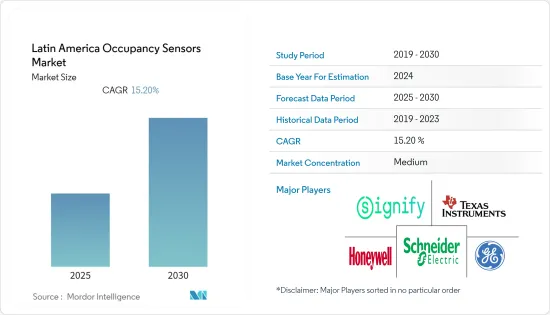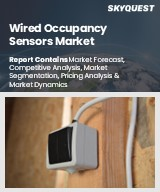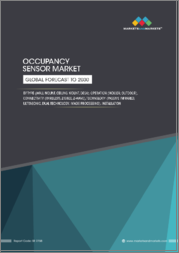
|
시장보고서
상품코드
1629767
라틴아메리카의 재실감지 센서 : 시장 점유율 분석, 산업 동향 및 통계, 성장 예측(2025-2030년)Latin America Occupancy Sensors - Market Share Analysis, Industry Trends & Statistics, Growth Forecasts (2025 - 2030) |
||||||
■ 보고서에 따라 최신 정보로 업데이트하여 보내드립니다. 배송일정은 문의해 주시기 바랍니다.
라틴아메리카의 재실감지 센서 시장은 예측 기간 동안 CAGR 15.2%를 기록할 것으로 예상됩니다.

주요 하이라이트
- 에너지 효율이 높은 장비에 대한 수요 증가가 이 지역의 원동력이 될 것으로 예상됩니다. 재실감지 센서는 에너지 소비를 줄이는 데 중요한 역할을 합니다. 이는 점유율에 따라 장치 및 기타 장비를 종료하는 센서를 통해 달성됩니다. 이러한 센서는 빛 공해를 줄이는 데 도움이 되며, 실내 및 실외 공간에 사용할 수 있습니다.
- 또한 에너지 낭비를 줄이기 위해 대부분의 에너지 법은 일정이나 점유율에 따라 조명을 사용하지 않을 때 조명을 자동으로 끄는 방법을 의무화하고 있습니다. 재실감지 센서는 사람이 없는 곳의 조명을 끄는 조명 제어 장치로, 에너지 낭비를 줄여 에너지 비용을 절감할 수 있습니다. 또한, 이 지역의 다양한 업체들이 초음파 센서를 도입하고 있는데, 초음파를 주변으로 발산하고 돌아오는 속도를 측정하여 사람의 존재를 감지합니다.
- 또한 패시브 적외선 기술과 초음파 기술을 모두 사용하여 거주자의 존재를 감지하고 두 기술이 모두 거주자의 존재를 감지할 때만 조명을 작동시키는 듀얼 기술 센서에 대한 관심도 증가하고 있습니다. 이러한 구성은 오작동 가능성을 거의 없애고, 두 기술 중 하나가 조명을 계속 켜야 하기 때문에 오작동 가능성도 크게 줄어듭니다.
- 재실감지 센서는 주로 카운팅, 위치, 추적, 신원 등 점유자의 존재 및 기타 보다 본질적인 특징보다는 움직임을 감지하는 데 주로 사용되어 왔습니다. 또한 새로운 기술은 더 높은 가치의 거주 특성을 감지하기 위해 빠르게 확장되고 있습니다.
라틴아메리카의 재실감지 센서 시장 동향
주택이 큰 성장을 이룰 것으로 예상
- 스마트 빌딩 기술의 도입으로 시설 관리자는 추정이나 추정에 의존하지 않고 공간 점유에 대한 정확한 정보에 액세스 할 수있는 강력한 도구를 사용할 수 있게 되었습니다. 또한, 재실감지 센서는 공간 사용에 대한 데이터를 수집하여 이 영역에서 공간 관리 의사결정을 최적화하는 데 도움을 주고 있습니다.
- 또한 기존 조명 제어 시스템에서 스마트 조명 제어 시스템으로 전환하면 가동률 감지, 시간표, 음성 제어를 통해 무선으로, 심지어 터치 없이도 조명을 제어할 수 있게 됩니다. 이에 따라 조명 제어 전문 기업들은 가정에 유연한 솔루션을 제공할 수 있는 새로운 기회를 얻게 되었습니다.
- 또한 광전 적외선(PIR) 센서는 현재 건물 내 거주자의 존재를 감지하는 표준입니다. 스마트 온도 조절기는 센서를 사용하여 거주 상황에 따라 냉난방을 제어합니다. 심각한 문제 중 하나는 이러한 PIR 센서가 움직이는 사람 만 감지한다는 것입니다.
- 또한, 거주 센서 및 스마트 콘센트 레퍼런스 디자인은 홈 오토메이션 기기 제조업체와 개발자들이 시스템 비용과 복잡성을 줄이면서 시장 출시 시간을 단축할 수 있도록 돕습니다. 개발자들은 인증된 무선 기술, 오픈 소스 하드웨어 설계 파일, 업계 표준 소프트웨어 스택, 검증된 테스트 셋업 제조 방법 등 새로운 턴키 레퍼런스 디자인을 활용하여 설계 개념에서 최종 제품까지 빠르게 진행할 수 있습니다.
멕시코에서 큰 성장이 예상
- 다양한 용도에 맞는 기술적으로 정교한 재실감지 센서가 등장하고, 사용자 친화적이고 신뢰할 수 있는 서비스를 제공하면서 보안 액세스 시스템에 대한 수요가 증가하고 있습니다. 또한, IT 기업, 기업, 데이터센터 등 다양한 상업 시설에서 직원들의 출입 시점을 기록하고, 인력 및 데이터 유출을 방지하기 위해 출입 관리 시스템을 도입하고 있습니다.
- 에너지 효율이 높은 장비에 대한 수요 증가가 이 나라를 견인할 것으로 예상됩니다. 재실감지 센서는 에너지 소비를 줄이는 데 중요한 역할을 합니다. 이는 작동 상태에 따라 장비 및 기타 설비를 정지시키는 센서를 통해 달성됩니다. 이 센서는 빛 공해를 줄이는 데 도움이 되며 실내 및 실외 공간에 사용할 수 있습니다.
- 패시브 적외선에 대한 국내 수요는 저비용, 에너지 효율이 높은 장비에 대한 수요, 적은 전력 요구로 인해 앞으로도 지속될 것으로 예상됩니다. 조명, 분광계, 가스, 화재 감지 시스템 등 다양한 용도가 있습니다. 패시브 적외선 센서의 가장 큰 장점은 정확한 움직임 감지, 신뢰할 수 있는 트리거링, 비용 효율성입니다. 예를 들어, 자동판매기 설계자들은 현재 PIR 센서를 제품에 통합하여 누군가가 기기 앞에 서 있거나 패널 앞에서 손을 흔들 때만 디스플레이가 켜지도록 하고 있습니다.
- 또한, COVID-19의 요청에 따라 멕시코 푸에블라에 설립된 인증된 친환경 병원인 Annexo La Margarita는 열 차단벽과 재실감지 센서와 같은 에너지 절약 요소를 도입하여 보다 친환경적인 건강 관리의 길을 열려고 노력하고 있습니다.
라틴아메리카의 재실감지 센서 산업 개요
라틴아메리카의 재실감지 센서 시장은 적당한 경쟁 상태에 있습니다. 제품 연구, 연구 개발, 제휴 및 인수는이 지역의 기업들이 치열한 경쟁을 유지하기 위해 채택하는 주요 성장 전략입니다.
- 2020년 3월 - 시그니파이(Signify)는 인터랙트 오피스(Interact Office)의 커넥티드 조명 시스템 및 환경 모니터링 API를 통해 데이터를 수집하고 전달하는 새로운 필립스 IoT 센서 패키지를 발표했습니다. 이 센서 번들은 점유율, 재실자 수, 온도(실내 및 책상 수준), 소음 수준, 일조량, 상대 습도를 관찰할 수 있으며, 블루투스를 지원하여 실내 위치 확인 및 탐색이 가능합니다.
- 2021년 1월 - Eyeris Technologies, Inc.는 CES 2021에서 TI의 JacintoTM TDA4 프로세서와 2D RGB-IR 이미지 센서를 활용한 업계 최초의 차량용 센싱 AI 솔루션에 대한 텍사스 인스트루먼트(TI)와의 협력을 발표했습니다. Eyeris DNN은 기능 안전 기준을 충족하고, 카메라의 유연한 배치가 가능하며, 저전력 엣지 프로세서에서 효율적으로 작동하도록 설계되어 저전력으로 작동하도록 설계되었습니다. 알고리즘 포트폴리오에는 세계 NCAP 표준을 충족하는 운전자 모니터링 시스템(DMS) 및 탑승자 모니터링 시스템(OMS) 기능이 포함되어 있습니다.
기타 혜택:
- 엑셀 형식의 시장 예측(ME) 시트
- 3개월간의 애널리스트 지원
목차
제1장 소개
- 조사 가정과 시장 정의
- 조사 범위
제2장 조사 방법
제3장 주요 요약
제4장 시장 인사이트
- 시장 개요
- 업계의 매력 - Porter's Five Forces 분석
- 공급 기업의 교섭력
- 소비자의 협상력
- 신규 참여업체의 위협
- 대체품의 위협
- 경쟁 기업 간의 경쟁 강도
- COVID-19의 시장에 대한 영향 평가
제5장 시장 역학
- 시장 성장 촉진요인
- 에너지 효율적 기기에 대한 수요 증가
- 저비용과 높은 에너지 효율에 의한 패시브 적외선 수요
- 시장 과제
- 무선 네트워크 시스템과 관련된 스위치 오작동과 부정합 문제
제6장 시장 세분화
- 네트워크 유형별
- 유선
- 무선
- 기술별
- 초음파
- 패시브 적외선
- 마이크로파
- 용도별
- 조명 제어
- 공조
- 보안과 감시
- 건물 유형별
- 주택
- 상업시설
- 국가별
- 브라질
- 멕시코
- 아르헨티나
- 기타 라틴아메리카
제7장 경쟁 구도
- 기업 개요
- Schneider Electric SE
- Eaton Corp PLC
- Signify Holding BV
- Honeywell Inc
- Dwyer Instruments Inc
- Johnson Controls Inc
- General Electric Co
- Legrand SA
- Analog Devices Inc
- Texas Instruments Inc
제8장 투자 분석
제9장 시장 전망
ksm 25.01.20The Latin America Occupancy Sensors Market is expected to register a CAGR of 15.2% during the forecast period.

Key Highlights
- The rising demand for energy-efficient devices is expected to drive the region. Occupancy sensors play a vital role in reducing energy consumption. This is achieved through the sensors, which shut down devices and other equipment based on occupancy. These sensors help reduce light pollution and can be used for indoor and outdoor spaces.
- Further, to reduce energy waste, most energy codes require some method of automatically turning off lights when they are not in use, either on a schedule or based on occupancy. Occupancy sensors are lighting controls that turn off lights in unoccupied areas, lowering energy costs by reducing energy waste. Also, various vendors in the region are introducing Ultrasonic sensors to detect the presence of people by emitting ultrasonic sound waves into the environment and measuring the speed with which they return.
- Also, there is an increasing focus on Dual-technology sensors that use both passive infrared and ultrasonic technologies to detect the presence of occupants and activate the lights only when both technologies detect the presence of occupants. This configuration virtually eliminates the possibility of false-on problems, and requiring either technology to keep the lights on significantly reduces the possibility of false-off problems.
- Occupancy sensors have primarily been used to detect motion rather than the presence or other more essential occupancy features, including count, location, track, and identity. Also, New technology is expanding rapidly to detect higher-value features of occupancy.
Latin America Occupancy Sensors Market Trends
Residential is Expected to Witness Significant Growth
- With the introduction of smart building technologies, facility managers now have access to robust tools to access accurate information about space occupancy rather than relying on estimates and approximations and occupancy sensors aiding in collecting data about space usage and optimizing space management decisions in the region.
- Also, switch from a traditional lighting control system to a smart lighting control system, which allows for wireless and even touchless lighting control through occupancy sensing, time scheduling, and voice control. All of this has opened up new opportunities for professional lighting control companies, which provide flexible solutions to homes.
- Further, Photoelectric infrared (PIR) sensors are the current standard for detecting occupancy presence in buildings. Smart thermostats use sensors to control heating and cooling based on occupancy. One significant issue is that these PIR sensors only detect individuals moving.
- Additionally, occupancy sensor and smart outlet reference designs help home automation device makers and developers accelerate time to market while lowering system cost and complexity. Developers can quickly advance from design concept to final product by leveraging these new, turnkey reference designs, including pre-certified wireless technology, open-source hardware design files, industry-standard software stacks, and proven test setups manufacturing methods.
Mexico is Expected to Witness Significant Growth
- The initiation of technically sophisticated occupancy sensors for various applications fuels security and access systems demand by providing a user-friendly and reliable service. Aside from that, various commercial establishments such as IT companies, enterprises, data centers are implementing access control systems to protect personnel and data breaches, to record employee's entry and exit timings.
- The rising demand for energy-efficient devices is expected to drive the country. Occupancy sensors play a vital role in reducing energy consumption. This is achieved through the sensors, which shut down devices and other equipment based on occupancy. These sensors help reduce light pollution and can be used for indoor and outdoor spaces.
- The demand for passive infrared is expected to continue in the country due to the low cost, demand for energy-efficient devices, and less power requirement. It has a range of applications, such as lighting, spectrometers, gas, and fire detection systems. Some of the significant benefits of passive infrared sensors are accurate movement detection, reliable triggering, and cost-efficiency. Vending machine designers, for instance, are now incorporating PIR sensors into their products so that their displays only light up when someone is standing in front of the unit or maybe waving their hand in front of a panel, which saves on operating costs.
- Further, in response to requests from Covid-19, a certified green hospital, Anexo La Margarita, established in Puebla, Mexico, intends to pioneer the path for more environmentally friendly healthcare by incorporating energy-saving elements such as thermal walls and occupancy sensors.
Latin America Occupancy Sensors Industry Overview
The Latin America Occupancy Sensors Market is moderately competitive in nature. Product launches, high expense on research and development, partnerships, and acquisitions are the prime growth strategies adopted by the companies in the region to sustain the intense competition.
- March 2020 - Signify introduced new Philips IoT sensor packages that gather and deliver data via the Interact Office connected lighting system and environmental monitoring APIs. The sensor bundles can observe occupancy, the total of people in the room, temperature (at the room and desk level), noise levels, daylight levels, relative humidity, and are Bluetooth enabled, allowing for indoor positioning and navigation.
- January 2021 - Eyeris Technologies, Inc. announced a collaboration with Texas Instruments (TI) on an industry-first in-cabin sensing AI solution at the Consumer Electronics Show (CES) 2021, utilizing TI's JacintoTM TDA4 processors and 2D RGB-IR image sensors. Eyeris DNNs are designed to meet functional safety standards, allow for flexible camera placement, and perform efficiently on low-power edge processors. Eyeris' AI algorithm portfolio for in-cabin sensing includes driver monitoring system (DMS) and occupant monitoring system (OMS) features that meet global NCAP standards.
Additional Benefits:
- The market estimate (ME) sheet in Excel format
- 3 months of analyst support
TABLE OF CONTENTS
1 INTRODUCTION
- 1.1 Study Assumptions and Market Definition
- 1.2 Scope of the Study
2 RESEARCH METHODOLOGY
3 EXECUTIVE SUMMARY
4 MARKET INSIGHTS
- 4.1 Market Overview
- 4.2 Industry Attractiveness - Porter's Five Forces Analysis
- 4.2.1 Bargaining Power of Suppliers
- 4.2.2 Bargaining Power of Consumers
- 4.2.3 Threat of New Entrants
- 4.2.4 Threat of Substitutes
- 4.2.5 Intensity of Competitive Rivalry
- 4.3 Assessment of the Impact of COVID-19 on the Market
5 MARKET DYNAMICS
- 5.1 Market Drivers
- 5.1.1 Rising demand for energy-efficient devices
- 5.1.2 Demand for Passive Infrared Due to Low Cost and High Energy Efficiency
- 5.2 Market Challenges
- 5.2.1 False Triggering of Switch and Inconsistency Issues Associated with Wireless Network Systems
6 MARKET SEGMENTATION
- 6.1 By Network Type
- 6.1.1 Wired
- 6.1.2 Wireless
- 6.2 By Technology
- 6.2.1 Ultrasonic
- 6.2.2 Passive Infrared
- 6.2.3 Microwave
- 6.3 By Application
- 6.3.1 Lighting Control
- 6.3.2 HVAC
- 6.3.3 Security and Surveillance
- 6.4 By Building Type
- 6.4.1 Residential
- 6.4.2 Commercial
- 6.5 By Country
- 6.5.1 Brazil
- 6.5.2 Mexico
- 6.5.3 Argentina
- 6.5.4 Rest of Latin America
7 COMPETITIVE LANDSCAPE
- 7.1 Company Profiles
- 7.1.1 Schneider Electric SE
- 7.1.2 Eaton Corp PLC
- 7.1.3 Signify Holding BV
- 7.1.4 Honeywell Inc
- 7.1.5 Dwyer Instruments Inc
- 7.1.6 Johnson Controls Inc
- 7.1.7 General Electric Co
- 7.1.8 Legrand SA
- 7.1.9 Analog Devices Inc
- 7.1.10 Texas Instruments Inc
8 INVESTMENT ANALYSIS
9 FUTURE OF THE MARKET
샘플 요청 목록



















